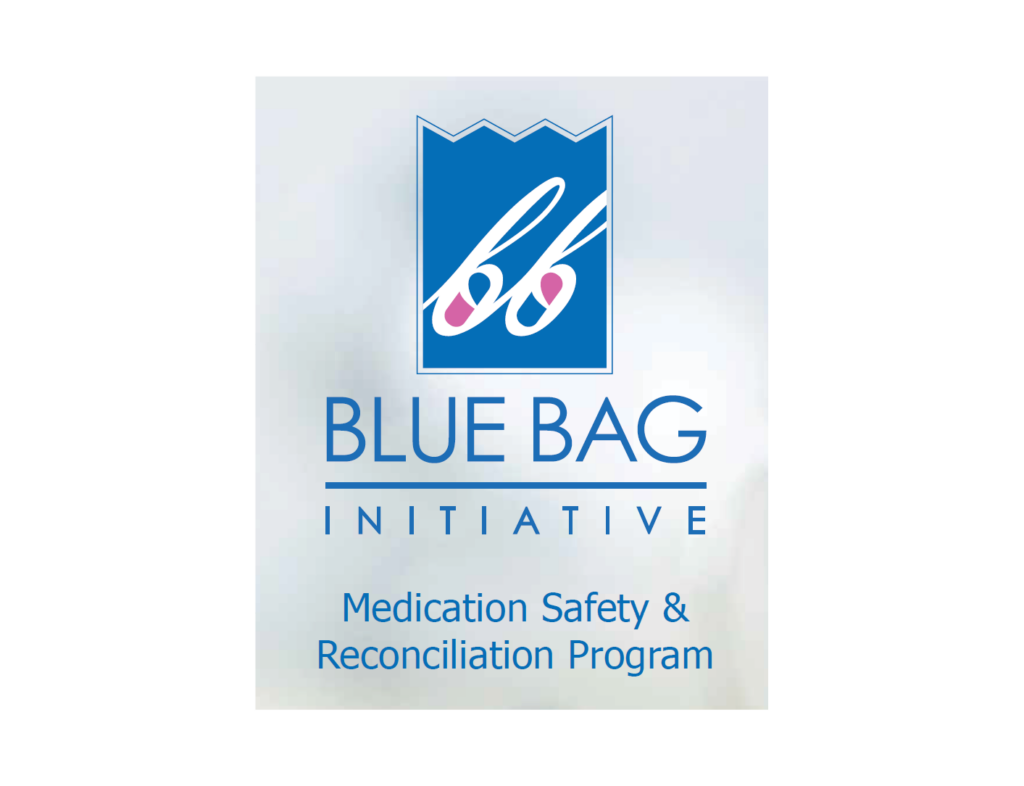
Including pharmacists on the health care team and incorporating a comprehensive medication review that identifies potential Adverse Drug Events (pADEs) into care processes achieves many benefits. Advantages include the prevention of ADEs, reduction of unnecessary hospital utilization, cost-savings to the system, engagement of the patient, and improved health outcomes.
The Blue Bag Initiative (BBI) is a program that includes a comprehensive medication review, increases the consistency of data collection, encourages patient engagement through understanding, and empowers the patient in the management of their medications. Preventable adverse drug events (ADEs) increase healthcare costs and can occur at any stage of medication use. 1,2
Recently, two pharmacists who use the Blue Bag Initiative (BBI) in the hospital setting shared their enthusiasm for the process, successes and patient impacts.
Diane McClaskey, RPh, BCPS is the Ambulatory Care Pharmacist at Citizens Memorial Hospital in Bolivar, Missouri. Staff started using the BBI in a clinic setting with chronic care management patients. Because the cost-savings and patient activation data they received within the Blue Bag reports from HQIN were so well-received by their leadership, they decided to add a pharmacist-conducted medication review to their hospital admission process.
After implementing the BBI, Diane said she is experiencing more instances of education to patients regarding their regimen and is working closely with providers to optimize drug therapy, avoid drug-drug interaction and reduce adverse drug reactions. She frequently acts as a bridge between the provider and the community pharmacy to help reconcile patients’ medications as duplicative therapies are identified. Diane also said she was able to help a patient who was experiencing falls from hypoglycemia by coordinating with the prescriber to consider sliding-scale insulin dosing and other more affordable medications. BBI has also enhanced Diane’s intake worksheet and process to include its pADE review elements.
At Buchannan General Hospital in Grundy, Virginia, Makayla Funk, PharmD, and her team have continued the BBI within the BuchannanCares Program, which started as a pilot program to prevent hospital readmissions during the early days of COVID-19. Their integration of a pharmacist’s comprehensive medication review at discharge impacted 100% of the patients’ readmissions. They also increased their HCAHPS scores with patients confirming they received an effective explanation of their medications (12% increase from 80 to 92%) and patients confirming the explanation of their medication side effects (35% increase from 50 to 85%).
The activities of this successful trial have been integrated into their current discharge processes. Makayla said she witnesses examples of the program’s success every day. Her medication reviews with families and patients have helped people learn about new health conditions along with their prescription coverages (or the lack thereof). She has also identified if patients have not been taking their medications because of the cost. This has led to communicating with physicians about the barrier and collaborating to develop more affordable and effective regimens. Makayla said they recently had a patient in this situation who has not had to return to the hospital after receiving assistance.
“A lot of our patients end up needing some transition of care whether it be a nursing home, assisted living, a new caregiver, or even transitioning back to home after a stay at the hospital,” said Makayla. “That’s why I think doing these complete medication reviews is so important. As pharmacists, we wear many hats including patient advocates, and it’s so important that we give them all the information they need to take their medications safely and confidently. It can be so scary getting discharged from the hospital and possibly going into a completely new environment, so taking the time to go over their medications and make sure they understand how and why they are taking them can be empowering for patients or their caregivers.”
“It takes a village to take care of the sick and pharmacists are a major part of that village,” she added. “Whether we’re counseling a new caregiver, trying to help a patient with financial struggles or talking with patients about lifestyle changes, we can have such a big impact on patient outcomes. Luckily the village I’m in has doctors, nurses and executives that really appreciate the value a pharmacist brings.”
A pharmacist-led Blue Bag medication review can prevent a substantial number of potential ADEs and, as a result achieve appreciable cost savings. If you are interested in learning more or implementing the Blue Bag Initiative, contact bluebag@hqi.solutions.
1Tache’ SV, Sonnichsen S, Ashcroft DM, Prevalence of adverse drug events in ambulatory care; asystematic review. Ann Pharmacother. 2011; 45(708):977-989.
2Gurqitz JH, Field TS, Harrold Lr, et al. Incidence and preventability of adverse drug events among older persons in the ambulatory setting. JAMA, 2003;289(9);1107-1116.
